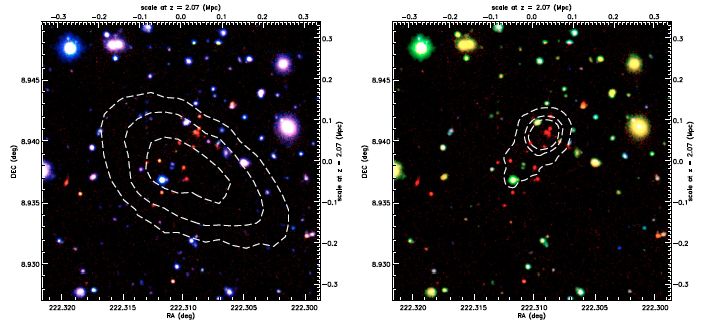
RGB composite colour images of the 1.4’×1.4’ field centred on the galaxy overdensity. The R channel of both imagescorresponds to the Ks band; the G and B channels corresponds to the J and z bands in the left image and to the B and z bands in the right one. The B and z images were taken using the Suprime-Cam instrument on the Subaru telescope while the J and Ks images are a composite of MOIRCS and ISAAC data, on the Subaru and VLT observatories. The BzKs image shows how the red galaxies are basically unseen at optical wavelengths. On the left, the white overlapping contours show the 1, 2, and 3σ significance levels of the diffuse X-ray emission in the XMM-Newton image, after subtraction of a point source seen in the Chandra image and smoothing with a 8” radius PSF (as described in Section 5). On the right, they show the 10, 20, and 30σ levels above the background galaxy number density, computed using the 5 estimator
We report evidence of a fully established galaxy cluster at z=2.07, consisting of a ~20sigma overdensity of red, compact spheroidal galaxies spatially coinciding with extended X-ray emission detected with XMM-Newton. We use VLT VIMOS and FORS2 spectra and deep Subaru, VLT and Spitzer imaging to estimate the redshift of the structure from a prominent z=2.07 spectroscopic redshift spike of emission-line galaxies, concordant with the accurate 12-band photometric redshifts of the red galaxies. Using NICMOS and Keck AO observations, we find that the red galaxies have elliptical morphologies and compact cores. While they do not form a tight red sequence, their colours are consistent with that of a >1.3$~Gyr population observed at z~2.1. From an X-ray luminosity of .2*10^43 erg s^-1 and the stellar mass content of the red galaxy population, we estimate a halo mass of 5.3-8*10^13 Msun, comparable to the nearby Virgo cluster. These properties imply that this structure could be the most distant, mature cluster known to date and that X-ray luminous, elliptical-dominated clusters are already forming at substantially earlier epochs than previously known.
See the website for more details.http://arxiv.org/PS_cache/arxiv/pdf/1011/1011.1837v2.pdf (SY)
